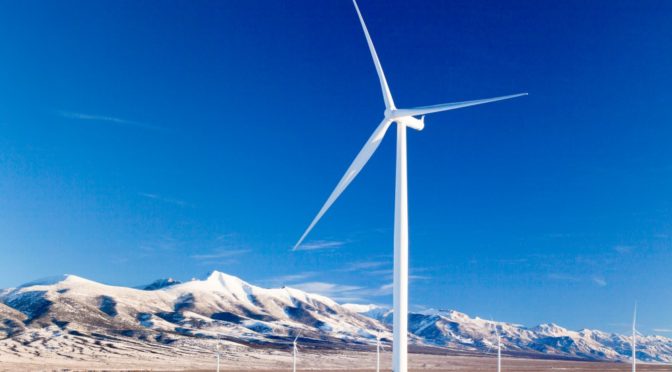The future of federal policies to cut carbon dioxide pollution for existing power plants, such as the Environmental Protection Agency’s Clean Power Plan rule, remains uncertain for the near term. But even with this uncertainty on carbon policy, other factors will continue to drive wind energy’s astronomical growth — benefiting in particular the rural and Rust Belt areas that are starved of economic opportunity.
As leading economists from all political perspectives have argued, incorporating carbon policy into energy markets results in more efficient market outcomes. It also improves American competitiveness by maintaining our lead in developing innovative energy technologies.
Last year, wind surpassed hydropower to become the county’s largest source of renewable generating capacity, and the fourth-largest capacity source behind natural gas, coal, and nuclear. Wind energy provides enough electricity to power 24 million American homes and is on track to nearly double that by 2020.
Cost declines and technology advances have made this growth possible. The cost of wind energy has fallen 66% in seven years as wind turbines became 50% more productive, and those improvements continue. In many parts of the country, wind is already the lowest-cost source of new electricity.
Recent announcements confirm that electric utilities, large businesses and states are moving full speed ahead with buying wind power because it makes economic sense. They realize they can save money and lower fuel-price risk with stably-priced wind energy, while also protecting clean air and water.
Since the election, the nation’s largest electric utilities have continued to invest in renewable energy, with many noting that policies to limit carbon pollution are inevitable.

This month, Oregon-based Pacific Power (part of a company majority-owned Berkshire Hathaway BRK.A, +0.82% BRK.B, +0.83% ) announced it will invest $3.5 billion in new wind projects. “This is a win-win and represents our continued commitment to both reduce the environmental impact of the energy we produce and keep costs low,” said CEO Stefan Bird.
Likewise, American Electric Power’s AEP, -0.38% CEO stated: “We’re moving to a cleaner-energy economy, and we’re still getting pressure from investors to reduce carbon emissions. I don’t see that changing.”
“Markets are driving a lot of the behavior,” said a spokesman for Duke Energy DUK, -0.19% “[W]e’ll continue to move toward a lower carbon energy mix.”
Large corporations continue to invest in wind because it saves them money.
Google GOOG, +0.96% GOOGL, +1.06% expects to run all of its worldwide operations using renewable energy in 2017, with wind supplying 95% of that electricity.
Earlier this year, Home Depot HD, +1.21% purchased enough wind energy to power 100 of its Texas stores. A General Motors GM, +0.00% factory in Texas that builds 125,000 SUVs a year has signed a contract to meet 100% of its electricity needs with wind energy next year.
Last month Anheuser-Busch InBev BUD, +1.53% announced plans to transition to 100% renewable energy by 2025, joining 88 other companies that have made the same commitment.
States are also leading the way on wind energy because it brings jobs, environmental benefits and consumer savings. Twenty-nine states have passed policies to obtain a significant percentage of their electricity from renewable sources, and many are setting the bar higher after reaching initial targets.
Last year Oregon and New York nearly doubled their renewable standards to 50%, following California’s lead. Maryland, Michigan and Washington, D.C. also increased their targets last year. In total, states representing over a quarter of the U.S. population have raised their renewable targets over the last two years.
Today, more than 100,000 Americans work in the wind industry, with employees in all 50 states. Over 25,000 of these workers manufacture wind power components at more than 500 U.S. factories. Meanwhile, wind turbine technician is by far the country’s fastest-growing job, according to the U.S. Bureau of Labor Statistics.
Even better, these numbers will continue to grow. According to recent analysis from Navigant Consulting, total wind-driven employment could near a quarter of a million by 2020, with $85 billion in economic activity over the next four years.
The largest beneficiaries of this investment are the rural and Rust Belt communities that need it the most. Ninety-nine percent of wind energy is deployed in rural areas, mostly in places that fall below the poverty line. Wind projects bring jobs, landowner lease payments, property tax payments, and other economic activity to these communities. The Southeast and Great Lakes states have emerged as wind manufacturing hubs, and it is noteworthy that the top 10 congressional districts for wind power are all represented by Republicans.
Stable carbon policy would enable the American wind industry to make long-term investments in the U.S. workforce, factories, and research and development, further improving our competitiveness. Regardless of what happens, wind power will continue to grow, creating jobs and keeping energy costs low.
Michael Goggin is senior director of research at the American Wind Energy Association.


